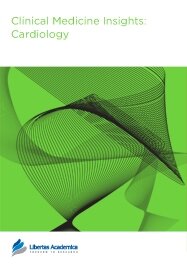

Publication Date: 20 Dec 2010
Type: Original Research
Journal: Clinical Medicine Insights: Cardiology
doi: 10.4137/CMC.S6452

Background: Doppler echocardiographic studies of the left ventricle (LV) function in patients with β-Thalassemia Major (β-TM) had shown different patterns of systolic and diastolic dysfunctions associated with abnormal serum brain natriuretic peptide (BNP).
Aim: This cross-sectional study was designed to study the LV systolic and diastolic functions and correlate that with serum level of N-terminal pro brain natriuretic hormone (NT- pro BNP) in patients with β-TM using Pulsed Doppler (PD) and Tissue Doppler (TD) echocardiography.
Methods: The study was conducted on patients with β-TM (n = 38, age 15.7 ± 8.9 years) and compared with an age-matched controls (n = 38, age 15.9 ± 8.9 years). In all participants, PD and TD echocardiography were performed and blood samples were withdrawn for measuring the serum level of NT-pro BNP, ferritin, and alanine transaminase.
Results: Patients with β-TM compared with controls, have thicker LV septal wall index (0.65 ± 0.26 vs. 0.44 ± 0.21 cm, P < 0.001), posterior wall index (0.65 ± 0.23 vs. 0.43 ± 0.21 cm, P < 0.01), and larger LVEDD index (4.35 ± 0.69 vs.3.88 ± 0.153 mm, P < 0.001). In addition, β-TM patients have higher transmitral E wave velocity (E) (70.818 ± 10.139 vs. 57.532 ± 10.139, p = 0.027) and E/A ratio (1.54 ± 0.17 vs. 1.23 ± 0.19, P < 0.01) and shorter deceleration time (DT) (160.13 ± 13.3 vs. 170.50 ± 19.20 m sec, P < 0.01). Furthermore, the ratio of transmitral E wave velocity to the tissue Doppler E wave at the basal septal mitral annulus (E/Em-) was significantly higher in β-TM group (19.6 ± 2.81 vs. 13.868 ± 1.41, P < 0.05). The tissue doppler systolic wave (Sm) velocity and the early diastolic wave (Em) were significantly lower in β-TM group compared to controls (Sm: 4.82 ± 1.2 vs. 6.22 ± 2.1 mm/sec, P < 0.05; Em: 3.51 ± 2.7 vs. 4.12 ± 2.5 mm/sec P < 0.05, respectively). The tricuspid valve velocity was significantly higher in β-TM patients compared with controls (2.993 ± 0.569 vs. 1.93 ± 0.471 m/sec, respectively, P < 0.01). The mean serum NT pro-BNP in β-TM was significantly higher compared with controls (37.6 ± 14.73 vs. 5.5 ± 5.4pg/ml, P < 0.05). The left ventricle ejection fraction (EF%) and fractional shortening (FS%) were not significantly different between both groups.
Conclusion: We conclude that patients with β-TM had a significantly higher serum level of NT-pro BNP that is positively correlated with the E/Em ratio on tissue Doppler. Furthermore, we confirm our previous findings that patients with β-TM exhibit LV diastolic pattern on echocardiogram suggestive of restrictive type with well preserved left ventricle systolic function.
PDF (521.05 KB PDF FORMAT)
RIS citation (ENDNOTE, REFERENCE MANAGER, PROCITE, REFWORKS)
BibTex citation (BIBDESK, LATEX)
XML
PMC HTML
Clinical Medicine Insights: Cardiology is very much conscious of time. Every step is done thoroughly and rapidly. The reviewers' comments are constructive. There is regular contact with the authors, providing explanations where necessary. The visibility also enjoyed by one's article once it is published is worthy of note. Thanks for making publishing with you so easy and enjoyable.

All authors are surveyed after their articles are published. Authors are asked to rate their experience in a variety of areas, and their responses help us to monitor our performance. Presented here are their responses in some key areas. No 'poor' or 'very poor' responses were received; these are represented in the 'other' category.See Our Results
Copyright © 2013 Libertas Academica Ltd (except open access articles and accompanying metadata and supplementary files.)
FacebookGoogle+Twitter
PinterestTumblrYouTube